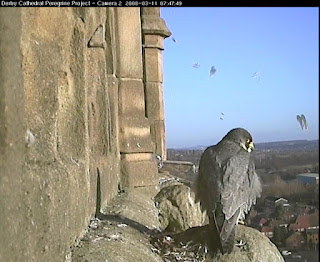It looks like Derby's peregrines are amongst the last to lay, judging by
Froona's comparison blog.
Yesterday evening our male peregrine was in the nest scrape alone, flying off just before dark. The nest remained empty until 2am when the female arrived, with the male just visible on the ledge below the platform. They both left soon afterwards, but at 3am she returned again, spending 5 minutes in the scrape before moving to the edge of the nest platform. She moved back in to the scrape at 4.30am when it started raining, but stayed there until 06:30 when she went back to the edge again. She finally flew off at 08:00 this morning. This is a change of
behaviour we've not seen this year, suggesting that she's perhaps only a few days away from egg laying.
As at 28th March, our birds are still actively displaying to one another. The clip below was captured just before dusk on Sunday 23rd. The male had already stood absolutely still, head bowed, for nearly five minutes before she decided it was her turn in the scrape. Being so much bigger, she soon got her way! My money did go on eggs to be laid around 1st April, but now I'm not so sure - we'll just have to wait and see.
Here are the dates and times people have suggested so far:
17 March, early morning - Jan, Dayton Ohio
21 March 8:00 am. - Anonymous
01 April @ 00.45 gmt -Lyndsey, Chesterfield
01 April 23:00 Nick M. Derby
02 April around 08.10 - Anonymous
03April, 3:45am. - Jennie, HK.
04 APR 16:20 -Spikennipper in Ashford, Kent.
07 April - Pax, Canada
08 May 10:02 AM. - Lewicki.
leave a comment if you want to add your own suggestions
 A second egg was laid sometime early on Monday morning. Our male promptly sat on them until noon, leaving our female peregrine falcon high up on the projecting lead gutter on the top of Derby Cathedral's tower.
A second egg was laid sometime early on Monday morning. Our male promptly sat on them until noon, leaving our female peregrine falcon high up on the projecting lead gutter on the top of Derby Cathedral's tower.








.jpg)



.JPG)



